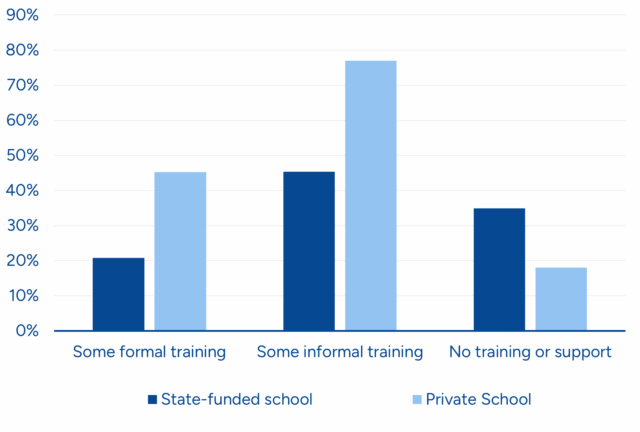Opinion
Today the Sutton Trust published its latest research, Artificial advantage? on the use of artificial intelligence (AI) by teachers in their work.
Through teacher polling conducted by Teacher Tapp, we identified that key gaps are emerging. If left unaddressed, these will lead to the following new AI digital divides in the education system:
- The preparedness gap
- The training gap
- The evidence gap
The preparedness gap refers to the differences between how ready different schools are to work safely and effectively with AI.
Research has shown that the more confident teachers are with technologies, the more effective they are in using them and the better they achieve student learning objectives. Having a school-wide AI policy or strategy is not only part of government guidance, it also means having a plan: the key issues of safety, effectiveness, practicalities, training, risks and benefits have at least been considered. Finally, having a staff member who is responsible for overseeing how AI is being used in school means coordination, monitoring and support should all be in place.
Our research found that while nearly a quarter (24%) of state school teachers said they were not at all confident using AI tools, this dropped to just 15% in private schools. 41% were either very or fairly confident in state schools compared to 51% in private schools. Meanwhile, private school teachers were three times more likely (21% vs 6%) to say their school has a clear school-wide staff strategy on using AI. Similarly, 57% of state school teachers said there was no staff member responsible for overseeing AI, compared to just 42% in private schools.
The training gap points to variation in the amount of training teachers in different schools have received. We found that private school teachers (45%) were more than twice as likely to have had formal training than their state school counterparts (21%).
Figure 1: Have you received any training or support on using AI in your role in the last 12 months? (School type)
In secondary schools the gap rose to 53% (private) vs 25% (state). Conversely, only 18% of private school teachers said they had received no training on how to use AI, compared to 38% of teachers in state schools.
The evidence gap is different. This is about the lack of an evidence base to inform school leaders and teachers of best practice in using AI in the classroom. 1 in 5 (19%) teachers said they were concerned about the lack of research into how AI affects learning, but this was something that also came up in our case study interviews. All interviewees stressed the importance of schools taking a cautious approach to introducing AI because of the risks of getting it wrong.
Emerging research has also pointed to the complexity of learning outcomes using AI, suggesting there can be both gains and losses. The Education Endowment Foundation (EEF) has also called for more research in this area. A recent comprehensive review on EdTech found that although there can be clear benefits, it also has the potential to be a gap-widener. Given the speed with which AI technologies are being developed and the array of tools on offer to schools, there is a clear need for more solid, independent evaluative research.
These three gaps are already emerging and need addressing urgently. The technology will not wait for government to develop a policy response. In the meantime, school leaders are being confronted right now with the challenges of getting AI right. This is why the Sutton Trust is calling for:
- Urgent additional training and guidance for school leaders on the use of AI.
- Provision of devices to all Pupil Premium pupils.
- Support for research into the pedagogic efficacy of AI tools, and incentives for tech companies to share their data with researchers.
- Monitoring of the use of AI in schools, with particular attention to inequalities in access and use.
- Digital literacy training to be included in ITT programmes.
- For all schools to have a staff member with responsibility for AI.
- For AI training to be compulsory in all teachers’ CPD.
This issue requires urgent attention. Not just to ensure AI is rolled out safely in schools, but also so all pupils in all schools can equally benefit from the advantages this technology has to offer.
